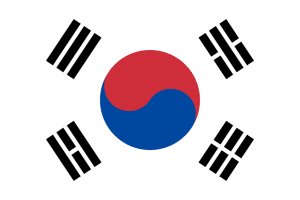
| Colors | HEX Code | RGB | CMYK |
|---|---|---|---|
| White | #FFFFFF | 255, 255, 255 | 0, 0, 0, 0 |
| Black | #000000 | 0, 0, 0 | 0, 0, 0, 100 |
| Red | #CD2E3A | 205, 46, 58 | 0, 78, 72, 20 |
| Blue | #0047A0 | 0, 71, 160 | 100, 56, 0, 37 |
The South Korean Flag, or Taegeukgi, has a white background. In the center, there is a red and blue taegeuk circle, and four black trigrams distributed as one in each corner of the flag.
Meaning of the South Korean Flag
The white color in the South Korean Flag represents brightness, purity, and peace. It also represents the land. The taegeuk is said to represent the people. It also signifies the harmony between the negative cosmic forces, represented by the blue portion (Yin), and the positive cosmic forces represented by the red portion (Yang). The central symbol on the flag emphasizes the truth that all things are created and evolve through the interaction of yin and yang. The four black trigrams symbolize the government, but it is also a symbol of the movement and harmony among these forces. They represent the sky, the earth, the water, and the fire. The flag is an embodiment of Koreans who seek continuous enrichment and creation.
History of the South Korean Flag
The flag of South Korea was adopted in 1882, but the symbols on the flag are much older. Korea was under Japanese colonial rule from 1910 to 1945. During Japan’s 36-year rule, the Korean flag was banned, only to be revived following Korea’s liberation at the end of World War II, when Japan surrendered to the Allies. Korea then was divided into southern and northern parts. North Korea had a flag inspired by the communist rule of the Soviets, while South Korea adopted the old flag. The flag was revived under General MacArthur in 1948, and was made official in 1949.